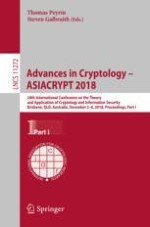The three-volume set of LNCS 11272, 11273, and 11274 constitutes the refereed proceedings of the 24th International Conference on the Theory and Application of Cryptology and Information Security, ASIACRYPT 2018, held in Brisbane, Australia, in December 2018.
The 65 revised full papers were carefully selected from 234 submissions. They are organized in topical sections on Post-Quantum Cryptanalysis; Encrypted Storage; Symmetric-Key Constructions; Lattice Cryptography; Quantum Symmetric Cryptanalysis; Zero-Knowledge; Public Key and Identity-Based Encryption; Side-Channels; Signatures; Leakage-Resilient Cryptography; Functional/Inner Product/Predicate Encryption; Multi-party Computation; ORQM; Real World Protocols; Secret Sharing; Isogeny Cryptography; and Foundations.
